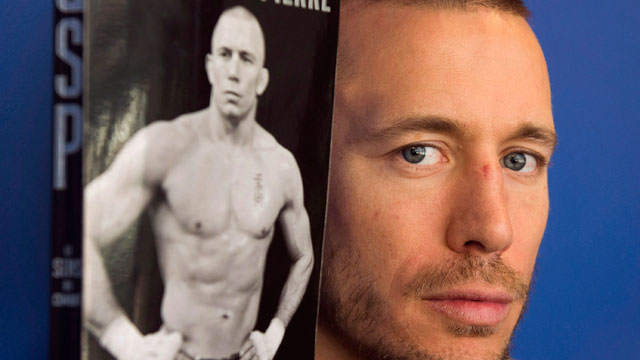The story of UFC welterweight champion Georges St-Pierre has been told and re-told by countless others, but the book about his life, written from his own perspective and bracketed by words from five people in his family and inner circle, portrays him in a completely different way. He’s a fighter who also happens to be a philosopher.
The Way Of The Fight, which was written during his rehabilitation from his major knee surgery in December 2011 that kept him out of action until his return almost a year later, is more about his way to conquer everyday fears that we all face and turn them into self-empowerment.
Fear is probably the dominant theme because he faced it early in his life. From the age of nine and continuing for three years until he was finally left alone, he regularly faced physical brutality from bullies. And yet he says the bullying actually helped him become a stronger person because he found a way to fight back – both literally and figuratively.
It is interesting that he talks about a time when he had a fight in school and won, breaking one of the arms of his opponent, which left him feeling ashamed because he thought others would look down upon him for what he had done. But it became just the opposite: he went from being an outcast to someone popular. He considered it b.s. and says the incident changed the way he viewed the world.
In his struggles to make sense of it all, he immersed himself in MMA training, which began when he started taking karate at age seven and escalated into other forms of combat. His focus became clearer: he wanted to become an MMA world champion and began a process to make it happen, notably late in his teenage years when he identified someone whom he felt could help him reach his goal.
Kristof Midoux, whom he refers to as his mentor/sensei, is portrayed as a larger than life figure in stature and importance. An MMA fighter who owned and operated a gym in Montreal, Midoux tested St-Pierre’s physical and mental endurance because he realized his potential to become a world champion, and his young protégé refused to back down from situations that may have forced others to quit.
What Midoux and others of importance to St-Pierre did is shape his mind as much as his body, in essence making him a multi-dimensional person. In fact, St-Pierre readily admits there are two sides to his personality: one that is not pleasant to be around as he nears a fight and assumes a darker side, and another which is fairly easygoing.
What is interesting about St-Pierre is how he views himself as a martial artist more than a mixed martial artist, even if he has multiple skill levels, because to him it is more about respect than sport. It is the reason he salutes each of his opponents before the fight begins.
“By stepping into the octagon, my adversary completes me,” he writes. “He makes my life possible. He becomes a part of my existence. To disrespect him is to disrespect myself. Thanks to him I become a better man. Thanks to his presence, I am a true martial artist.”
If you find that hard to believe, specifically in view of how Nick Diaz totally disrespected him, calling him a coward by using the knee injury to duck out of his fight at UFC 137, well, it’s worth noting Diaz is barely mentioned in the book. Perhaps that will come if he decides to add another chapter.
St-Pierre says trash talking is not a part of martial arts, hence he refrains from it, but he says he understands why fighters do it to psychologically help themselves and says some of it is amusing.
St-Pierre sees the world as a “knowledge hardware store” and every day he is just walking through the aisles, each of which has keys to open a different door.
Knowledge is power and this is what St-Pierre reinforces again and again like a jab.
He references the lessons he’s learned from some of his fights, notably the defeats. He lost the UFC welterweight belt in his first title defence, stopped by Matt Serra, who came into the fight as an 11-1 underdog. St-Pierre says he became emotionally unhinged by a shot to the back of the head and lost all his composure en route to the defeat by a technical knockout. He carried the loss with him for several months, which a friend told him was like carrying a brick every day that becomes increasingly heavier. His friend told him to get a brick, write Serra’s name on it and carry it with him from the time he awoke until he went to bed. He gradually was able to put Serra behind him because of trash talking by his next opponent, Josh Koscheck. When he was finally ready, St-Pierre drove to a bridge and threw the brick into the water where nobody would find it.
“And with it went the demon of Matt Serra,” he writes. “It felt really good. It was total deliverance. And it was immediate.”
He beat Koscheck, then beat Hughes and then Serra and is undefeated in his last 11 fights, defending his belt a record eight times.
There is a lot to learn from this book, and surely this is what St-Pierre has intended. He is a champion who has taken his life experiences and crafted them with some interesting thoughts. There are some humourous stories, but they get weighted down by the force of his many messages and analogies, such as the difference between dinosaurs and cockroaches. Dinosaurs, with which he‘s had a life-long interest, ruled the earth with their size but didn’t survive because they couldn’t adapt, while cockroaches are survival machines capable of living for a week with their heads cut off. St-Pierre’s purpose in making the analogy is to say it applies to fighting and probably any other sport because it’s not always the strong that survive – it takes brains, guts, tolerance and forward thinking. Some of those qualities are needed to work your way through this book.
He makes reference to Aristotle, Socrates, Martin Gray and Zen Buddhism and their influences on his life, while also touching upon the edicts and principles of martial arts gurus such as Bruce Lee and Miyamoto Musashi. St-Pierre’s world is a collage of themes that are complex. The angles from which he makes points about key themes pertaining to life are much like the angles he uses to deliver a punch, kick or takedown. There is a purpose to everything for St-Pierre because of his desire to keep moving forward in his goal to become a better fighter and a better human being.
But many of his ideas can be extrapolated to use as everyday learning tools.
“Progress, I’ve learned, comes from openness,” he writes at the end.
If you’re looking for a chronological blow-by-blow account of his career, this is not the book for you.
“My goal here is to write the greatest book ever written, including these words about fear,” he writes. “It doesn’t make any difference that this happens to be the first book I’ve ever written. What matters is the spirit in which it’s being being written – and, quite, simply, that it’s being written. The purpose is to become the best writer in my category (yes, page for page and pound for pound). I’m just not sure what the category is yet, and I’m not sure I should care.”
In its simplest form, this is another way for St-Pierre to build his brand, which he’s been able to do quite well with his entourage. He has been referred as the No. 1 attraction in the UFC and this helps to explain it, albeit from a subjective point of view. St-Pierre may be full of himself and his ideas, but it’s what he believes and it has worked well for him. You cannot argue with his success.


